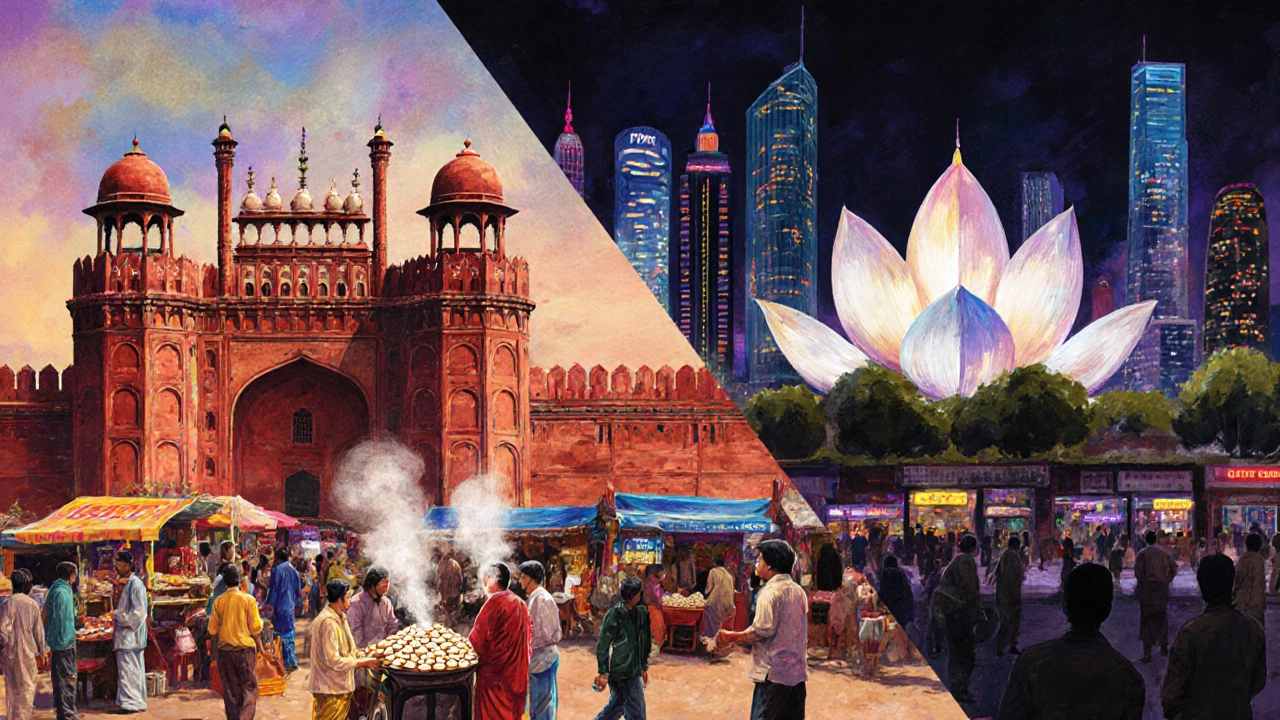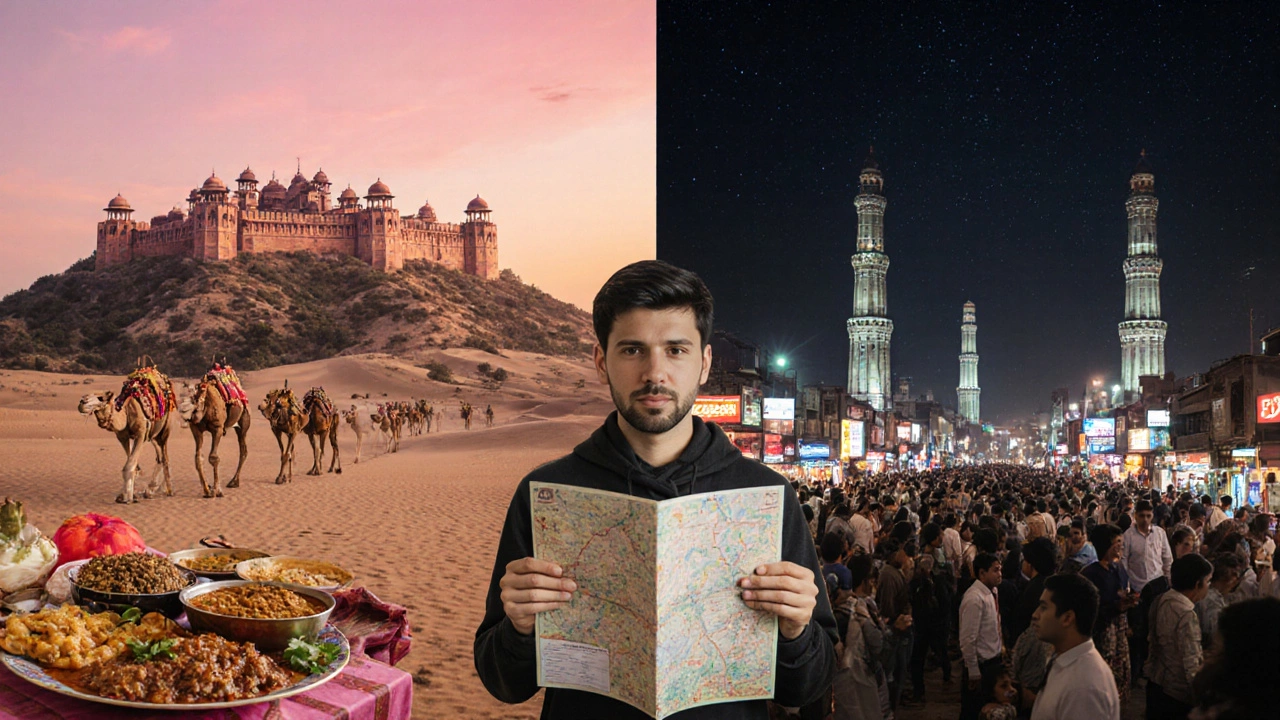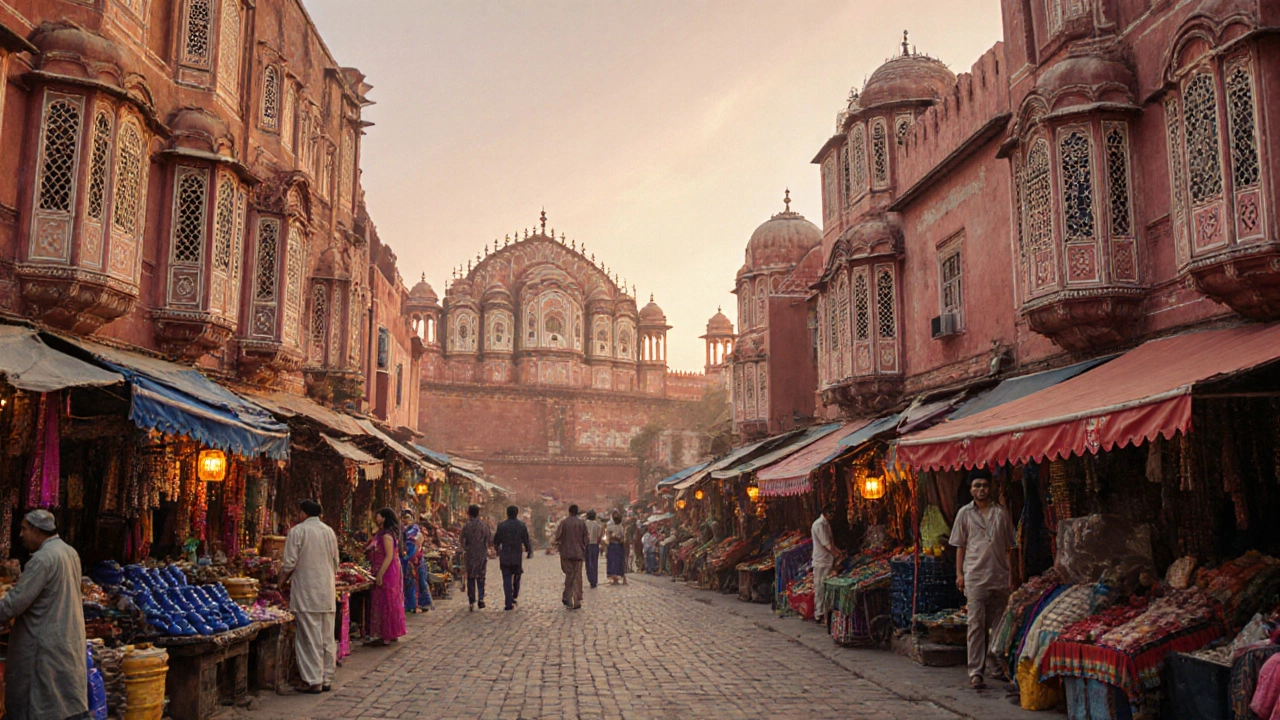Jaipur vs Delhi Cost Calculator
Calculate Your Trip Costs
Jaipur Estimated Costs
Delhi Estimated Costs
Trying to pick between two of North India’s biggest buzzwords can feel like debating pizza toppings - both sound great, but which one truly satisfies your travel cravings? Below we break down the headline‑grabbing question Jaipur vs Delhi across every angle that matters to a visitor, so you can decide without endless scrolling.
Quick Snapshot
Think of Jaipur as a living museum of Rajasthani royalty, where pastel walls and bustling bazaars create a storybook vibe. Delhi, on the other hand, is a megacity mash‑up of ancient forts, modern skyscrapers, and a food scene that never sleeps. Both claim a spot on any North India itinerary, but the experience they deliver differs dramatically.
Historical & Cultural Highlights
Jaipur is the capital city of Rajasthan, known as the Pink City for its distinctive terracotta‑toned architecture. Founded in 1727 by Maharaja Sawai Jaikishan, every street was planned on a grid, giving the city a surprisingly tidy feel for a historic hub. Tourist‑magazine surveys consistently rank Jaipur’s heritage festivals - like the Jaipur Literature Festival - among the most vibrant in the country.
Delhi is India’s capital territory, a blend of the ancient (Old Delhi) and the ultra‑modern (New Delhi). The city’s timeline stretches from the Indus Valley civilization to British colonial rule and the post‑independence era. Walking through Chandni Chowk feels like stepping back into the Mughal era, while the Rashtrapati Bhavan showcases British imperial grandeur.
Architecture & Landmarks
Jaipur’s crown jewels include the Hawa Mahal, a honey‑comb façade built in 1799 to let royal women watch street processions, and the Amber Fort, a hilltop palace complex with intricate mirror work. The city’s architecture leans heavily on pink sandstone, lime plaster and delicate jaali screens.
Delhi counters with the Red Fort, a UNESCO World Heritage Site whose red‑sandstone walls dominate the skyline, and the Lotus Temple, a modern glass marvel that draws millions of visitors each year. The capital also boasts the Qutub Minar, the world’s tallest brick minaret, standing at 73 meters.
Food & Nightlife
If you love hearty Rajasthani fare, Jaipur serves up dal‑baati‑churma, kebabs cooked over charcoal, and the sweet treat ghevar. The city’s rooftop dhabas provide open‑air dining under lantern light, creating a laid‑back vibe.
Delhi’s food scene is a gastronomic roller‑coaster. From street‑side golgappas in Connaught Place to fine‑dining experiences in Hauz Khas, the capital dishes out everything from Mughlai biryani to Punjabi butter chicken. Nightlife thrives in areas like Kha%20Ganj and Cyber Hub, where clubs stay open until dawn.

Shopping & Markets
Jaipur is a shopper’s paradise for traditional crafts. Bapu Bazaar and Johari Bazaar sell hand‑embroidered textiles, blue pottery, and gemstone‑laden jewelry. Prices are negotiable, and most artisans will happily share the story behind each piece.
Delhi offers a broader retail spectrum. From the luxury malls of Select Citywalk to the sprawling street market of Sarojini Nagar, you’ll find everything from designer labels to cheap knock‑offs. If you’re hunting for electronics, Nehru Place is the go‑to hub.
Accessibility & Transport
Jaipur is well‑connected by a domestic airport that receives daily flights from major Indian cities. Within the city, auto‑rickshaws and cycle‑riks dominate, and a new metro line (the Yellow Line) links the airport to the city centre, easing traffic congestion.
Delhi’s transport network is arguably the most extensive in India. Indira Gandhi International Airport is a major hub for both domestic and international flights. The Delhi Metro, with 10 colour‑coded lines, can whisk you from Connaught Place to the historic Red Fort in under 30 minutes. The city’s road network, however, can be chaotic during peak hours.
Cost & Visitor Experience
On average, a mid‑range traveler spends about INR 2,500 (~$30) per night in Jaipur for a decent hotel, while meals average INR 300‑500. Entry fees for major sites are modest (e.g., INR 200 for Amber Fort).
Delhi tends to be pricier for accommodation in central districts (INR 4,000‑7,000 per night for a 3‑star hotel) but offers a broader spectrum of options. Food costs are comparable, though street‑food premiums can rise in tourist hotspots. Entry fees to monuments like the Red Fort are INR 500, and some museums offer free days.

Quick Decision Guide
| Aspect | Jaipur | Delhi |
|---|---|---|
| Vibe | Royal heritage, laid‑back | Urban hustle, cosmopolitan |
| Top Attractions | Amber Fort, Hawa Mahal, City Palace | Red Fort, Qutub Minar, Lotus Temple |
| Food Highlights | Dal‑baati, Rajasthani sweets | Mughlai biryani, street chaat |
| Shopping | Handicrafts, textiles, jewelry | Markets, malls, electronics |
| Transport Ease | Compact city, new metro line | Extensive metro, busy roads |
| Average Nightly Cost (mid‑range) | INR 2,500 | INR 5,500 |
| Best For | History lovers, relaxed pace | Foodies, night‑owls, shoppers |
When to Visit
Jaipur’s peak tourist season runs from October to March, when the weather is cool (average 15‑25 °C). The city also hosts the Jaipur Literature Festival in January, attracting writers worldwide.
Delhi experiences pleasant weather from November to February (10‑20 °C). The capital’s festive calendar includes Diwali celebrations across Old Delhi and the International Mango Festival in May, which showcases India’s sweetest fruit varieties.
Final Verdict - Which City Wins?
If you crave a compact, picture‑perfect experience steeped in royal tradition, Jaipur edges out Delhi. Its cultural depth fits neatly into a 2‑3‑day itinerary, leaving you with time to relax and soak in the pink‑hued streets.
However, if you thrive on a fast‑paced environment, love street‑food adventures, and want a mix of ancient and ultra‑modern attractions, Delhi is the clear winner. The capital offers enough diversity to fill a week‑long stay without feeling repetitive.
Bottom line: your decision should hinge on the vibe you want. Pick Jaipur for a royal getaway; choose Delhi for an urban immersion that never sleeps.
Frequently Asked Questions
Is Jaipur safe for solo female travelers?
Yes. Jaipur’s main tourist zones are well‑policed, and most hotels provide reliable transport options. Stick to well‑lit streets after dark and use reputable auto‑rickshaws.
How long should I spend in Delhi to see the major sights?
Four to five days lets you explore Old Delhi’s forts, New Delhi’s museums, and fit in a day trip to Agra or the nearby heritage town of Mawana.
Can I do a day‑trip from Jaipur to nearby attractions?
Absolutely. The town of Pushkar, famous for its lake and camel fair, is a 2‑hour drive. The historic city of Ajmer is also a popular day‑trip option.
What’s the best time of year for shopping in Delhi’s markets?
Late October to December aligns with the festive season, when vendors stock up on fabrics, jewelry, and holiday gifts, and you can often snag discounts.
Do I need a visa to travel between Jaipur and Delhi?
No. Both cities are within India, so once you have an Indian visa (or are an Indian citizen), you can travel freely between them by train, bus, or flight.
